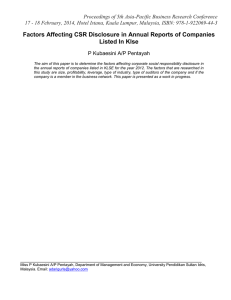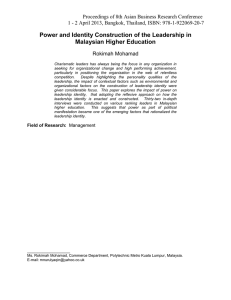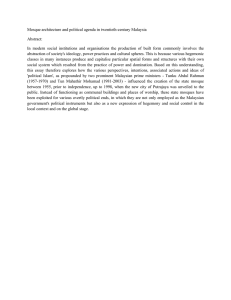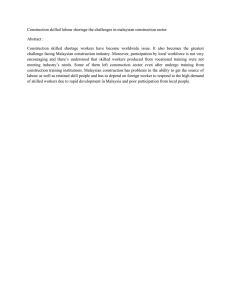26 Reflecting on Accounting Research Issues Chapter 2.indd 26
advertisement
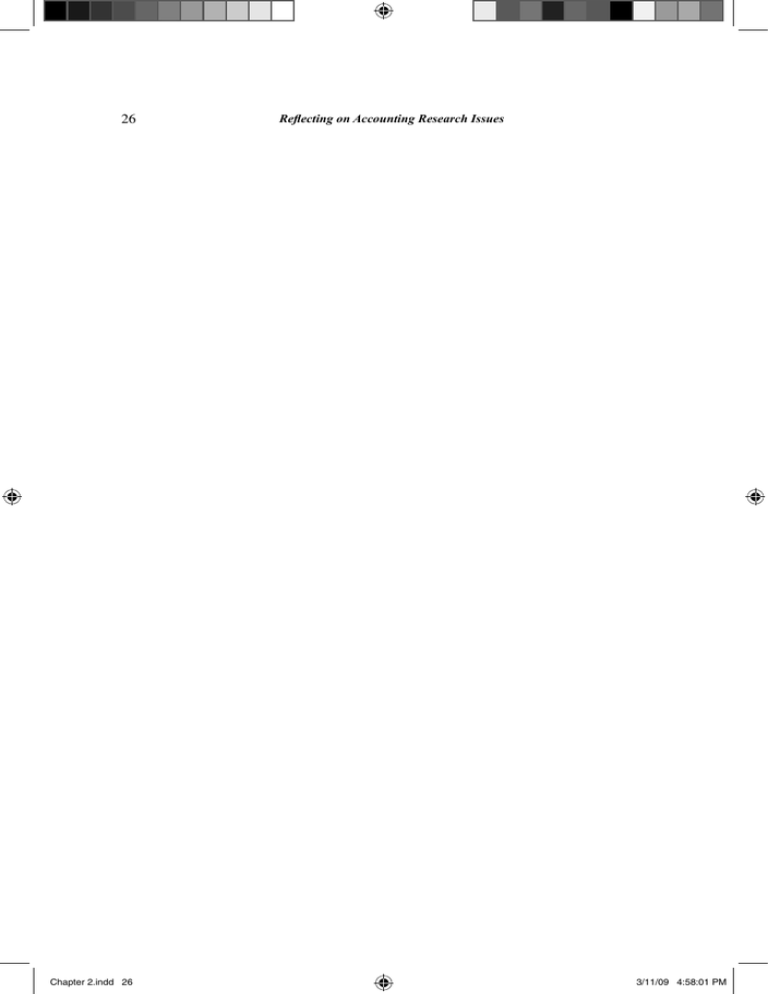
26 Chapter 2.indd 26 Reflecting on Accounting Research Issues 3/11/09 4:58:01 PM Accounting Changes Reporting in Malaysian Corporations 27 2 ACCOUNTING CHANGES REPORTING IN MALAYSIAN CORPORATIONS MOHD NOOR AZLI B. ALI KHAN INTRODUCTION Changes in accounting and financial reporting are inevitable (Hall & Aldridge, 2007). Hall and Aldridge (2007) stated that this happens because in preparing periodic financial statements, companies must take estimates and judgements to allocate costs and revenues. Accounting disclosure especially notification of information on a business unit has become a widely studied area in the West (Benston, 1973). The issue of accounting change has been subject to considerable research attention during the 1990s. The main interest has been directed at exploring changes in: accounting systems, accounting techniques, the accountancy profession, and the role of an accountant (for general references to such work, see Chua (1995) and Bhimani (1996)). In Malaysia, the accounting disclosure has yet to be studied vigorously (Hamzah, 1983). This however, does not mean that this issue is unimportant, and lately a lot of researchers have been researching on the report of extraordinary item (Shamsul & Nor Izah, 2000), cash flow statement (Ng, 1999), empirical studies on accounting and disclosure (Ng, 1998), uses of financial report (Azhar, 1999) and information that are needed by consumer and voluntary disclosures by the Kuala Lumpur Stock Exchange (KLSE), currently name as Bursa Malaysia listed companies (Tan et al., 1990). Disclosure is a means whereby information regarding a business unit can be conveyed. Based on this information, interested parties and potential investors will be informed of the strengths and weaknesses of a particular business unit, in terms of profits made, Chapter 2.indd 27 3/11/09 4:58:01 PM 28 Reflecting on Accounting Research Issues and/or whether the management of the business unit act in a manner which can be of benefit to the potential investors (Hamzah, 1983). Consistency in the accounting policy as stated in the Malaysian Accounting Standards Board (MASB) 1 is one of the accounting doctrine, which is the basis of financial planning and presentation. Users should be able to compare and differentiate every company financial statement for a period of time to identify financial position flow, performance, and cash flow. For that matter, the same accounting policy will be used for an accounting period. Changes in the accounting policy need to be done if directed by the law or the MASB, or if the change will give a more accurate result for presenting a situation or transaction in a company’s financial statement (MASB 3). This study is a preliminary study on the accounting disclosure by listed companies on the main board of the KLSE based on their annual financial report. The remainder of this paper is structured as follows. The next section provides an overview of accounting change. Section three discusses research methodology, followed by research findings. The paper ends with a conclusion and directions for future research. LITERATURE REVIEW A study done by May and Schneider (1988) shows that there has been some improvement in technical compliance with standards, but there is very strong evidence suggesting that management’s primary motivation in making accounting changes is not to achieve representational faithfulness, but rather to manage reported earnings. Studies of motivating factors have shown that changes frequently accomplished in suspected earnings goal apparently are to adopt a method that increases reported earnings in the current year (Cushing, 1969; Gosman, 1971). Gosman (1974) examined several characteristics of firms making accounting changes by comparing those firms given at least one consistency expectation by its auditors, Chapter 2.indd 28 3/11/09 4:58:01 PM Accounting Changes Reporting in Malaysian Corporations 29 during the 1958-68 period, with firms without such an expectation. Gosman (1973) investigated the characteristics of company making accounting changes. The sample consisted of the 1,000 annual reports issued for the 1959-1968 period by 100 firms randomly selected from those listed in the 1969 Fortune 500. Bremser (1975) studied an extension of the attributes of companies reporting accounting changes, with the nature of the reported earnings of these companies being the primary focus of the investigation. The major findings of this study are that the companies reporting accounting changes exhibited a poorer pattern of EPS and had lower ROI than the firms with no reported changes. Definition of Accounting Changes According to Gosman (1973), accounting change defined as any change in the method of applying generally accepted accounting principles. Kieso et al. (2001) defined that there are three types of accounting changes which are change in accounting principle, change in accounting estimate and change in reporting entity. According to MASB 3, there was no specific definition of accounting changes. However MASB 3 did mention about changes in accounting estimates, changes in accounting policies and fundamental errors. METHODOLOGY This study is aimed at gaining a better understanding of the practice of reporting accounting changes by listed companies on the main board of the KLSE based on the published annual report. Companies that are selected as samples were from the KLSE main board list from various industries. The industry classifications were set by the KLSE. From the annual report, data on financial year-ends, industry type, notes to the account, earnings per share, total assets, and audit firm will be used to examine the disclosure of accounting changes by listed companies at Bursa Malaysia. Chapter 2.indd 29 3/11/09 4:58:01 PM 30 Reflecting on Accounting Research Issues Random sampling technique is used in this study and companies are selected randomly based on the random number table. This random sampling technique is widely used by past researchers on the financial accounting reporting (Gosman, 1973; Bremser, 1975; Leong et al., 1989; Ng, 1999). Ng (1999) in his study of accounting issues and disclosure related to the International Accounting Standards (IAS) 2, used random sampling technique to select samples. Ng (1999) again in his study of disclosure related to cash flow statement of listed companies in Malaysia used the same technique. For the purpose of reporting accounting changes, the selected companies’ report from the year 1990 to 1999 were scrutinised to observe the accounting changes reporting trends for the period of ten years. Data was obtained from the library of the KLSE. Therefore selected companies must have been listed on the main board of the KLSE prior to the year 1990. As a whole, there were 37 companies and 370 annual reports examined (Table 1). Sample selection of 14% (37/271 x 100) of the companies’ population listed in the KLSE on December 31, 1990 is about 13% (Bremser, 1975) and 20% (Gosman, 1973) in the study sample selection. No. Industry Industry Sample Annual Report Sample (1990-1999) 1 Real Estate 8 8 10 = 80 2 Plantation 8 8 10 = 80 3 Industrial goods 8 8 10 = 80 4 Consumer goods 5 5 10 = 50 5 Trading/services 2 2 10 = 20 6 Mining 2 2 10 = 20 7 Finance 2 2 10 = 20 8 Construction 2 2 10 = 20 Total 37 370 Table 1: Selected Number of Companies and Annual Report Chapter 2.indd 30 3/11/09 4:58:01 PM 31 Accounting Changes Reporting in Malaysian Corporations FINDINGS Accounting Changes Disclosure Table 2 shows the accounting changes reported at least once a year by the study sample. Ten companies reported two year and four-year changes along the study period, which is 27.63%. On the other hand, eight companies reported three-year accounting changes (21.62%). Four companies disclosed five-year accounting changes (10.81%) and two reported six-year changes (5.41%). Only one company reported one, seven, and eight year changes (2.70%). Findings show that none of the selected companies did not report any changes. This clearly shows that at least once in ten years companies changed their accounting policy. Number of Accounting Changes (years) Number of Companies Percentage 1 1 2.70 2 10 27.03 3 8 21.62 4 10 27.03 5 4 10.81 6 2 5.41 7 1 2.70 8 1 2.70 Total 37 100.00 Table 2: Number of Accounting Changes Chapter 2.indd 31 3/11/09 4:58:02 PM 32 Reflecting on Accounting Research Issues Table 3 shows the type of change item reported. The most frequent reported item is the depreciation estimation. Followed by basis of consolidation, stock, expenses brought forward, retirement benefit, and amortisation. Intangible assets, associated companies, depreciation method, and mining exploration expenses only appeared once in the report. Based on the results obtained, it can be concluded that there were accounting changes reported in the companies’ annual report and the most frequently reported item is the depreciation estimation. This item reported to change frequently in the notes to the account. Item Type Frequency Percentage Depreciation Estimation 117 80.7 Consolidation basis 13 9.0 Stock 2 1.4 Expenses brought forward 3 2.1 Retirement benefit 4 2.8 Intangible assets 1 0.7 Amortisation 2 1.4 Associated companies 1 0.7 Depreciation method 1 0.7 Mining exploration expenses 1 0.7 Total 145 100.0 Table 3: Accounting Changes Item Type Accounting changes reporting flow direction Table 4 shows the annual accounting changes by according to their items. The year 1996 recorded the highest number of companies reporting accounting changes, the total is 21, while 1992 and 1999 Chapter 2.indd 32 3/11/09 4:58:02 PM Accounting Changes Reporting in Malaysian Corporations 33 recorded the lowest with only 12 companies. The most frequently reported item is the depreciation where the changes were exceeding 58% every year. Results obtained showed obvious increment in the depreciation estimation item between years 1992 to 1996. Based on Table 4, changes in the period of goodwill settlement occurred most frequently in 1994, a number of four companies made changes to the consolidation basis item in the period of ten years. 1995 showed two companies made changes to the stock item. Changes in the settlement period of expenses brought forward occurred in 1991, 1994, and 1996 with one company reporting. Changes in retirement reward assessment occurred in 1991 and 1996 with one company marking changes to the retirement benefit item and two companies in 1992. For the rest of the items, changes to the settlement period of intangible assets occurred in 1998 with one company reporting. Changes in the settlement of amortisation period occurred in 1997 and 1998, with one company reporting. Changes in the percentage of associated companies occurred in 1993 with one company reporting. In addition, changes in the depreciation method occurred in 1994 with also, one company reporting. Furthermore, changes in the settlement period for mining exploration expenses occurred in 1994 with one company reporting. Chapter 2.indd 33 3/11/09 4:58:02 PM Reflecting on Accounting Research Issues Table 4: Accounting Changes by Item 34 Chapter 2.indd 34 3/11/09 4:58:03 PM Accounting Changes Reporting in Malaysian Corporations 35 Insert Figure Here Figure 1: Accounting Changes Item by Year As shown in Figure 1, the number of changes reported yearly is volatile. The results of the study have some similarity with the study done by Frishkoff (1970), where it was found that there was an increase in the number of companies reporting accounting changes for the period of three years from 1967 to 1969. Frishkoff (1970) found that consolidation basis item was the most frequently reported item in 1967 and 1968, while depreciation method was the most frequently reported in 1969. However, this study found that there was an increase in accounting changes reporting from 1992 to 1994 and the most frequently reported item during the period of the study was depreciation item. From the findings it can be concluded that the direction of the accounting changes flow were reported in the annual report during the period of the study. Chapter 2.indd 35 3/11/09 4:58:03 PM 36 Reflecting on Accounting Research Issues CONCLUSION The objective of this paper is to examine the concept of disclosure and reporting of accounting changes in the financial statement. The results of the study show a volatile flow direction in the reporting of accounting changes. Obvious increment can be observed in the year 1992 until 1994. Depreciation item is the most frequently reported every year. The number of companies reporting is the most in the year 1996 with the total of 21 companies. 1992 recorded the least companies reporting with only 12. The finding also shows that none of the selected companies did not make any report for the period of ten years. At least once in ten years there are changes on the companies’ accounting policy. In a nutshell, this paper provides important insights into the type and trend of accounting changes by listed companies in Malaysia which are neglected by prior research. However, likes all studies, this study has its limitations. The first is the small sample size. This study managed to get 37 companies with 365 annual reports. A larger sample size would facilitate generalization from the results. Therefore, it would be interesting for researchers to further investigate this issue with a larger sample size. Future research of this subject matter can be determined with firm specific characteristics such as type of industry, profitability, leverage and audit firm. Finally, it is hoped that findings from this study would increase the awareness of the investing community (preparers, users, regulators and researchers) towards accounting changes. ACKNOWLEDGEMENT The author would like to acknowledge with thanks the assistance and the financial support provided by Universiti Teknologi Malaysia. I am grateful for comments received from the participants of the Irish Academy Management (IAM) Conference 2002, 5th – 6th September Chapter 2.indd 36 3/11/09 4:58:03 PM Accounting Changes Reporting in Malaysian Corporations 37 2009 at Waterford Institute of Technology (WIT), Waterford, Ireland and the 3rd Asian Academy Accounting Association (AAAA) 2002, 27th – 29th October 2002 at Nagoya Congress Centre, Nagoya, Japan. REFERENCE Azhar Abdul Rahman. (1999). “The use of annual reports by Malaysian financial analyst – A preliminary survey”. Akauntan Nasional, November/December, pp 26-32. Benston, George, J. (1973). “Required disclosure and stock market: an evaluation of the Securities Exchange Act of 1934”. The Accounting Review (March), pp 563-572. Bhimani, A. (1996). “Management accounting in the UK: reflections on research, practice and the profession”. In Bhimani, A. Management Accounting: European Perspectives, pp 218-241. Bremser, W.G. (1975). “The Earnings Characteristics of Firms Reporting Discretionary Accounting Changes”. The Accounting Review. July, pp 563-573. Chua, W.F. (1995). “Expert, networks and inscriptions in the fabrication of accounting images: a story of the representation of three public hospitals”. Accounting, Organizations and Society. Vol. 20. No. 2/3, pp 111-145. Cushing, B. E. (1969). “An empirical study of changes in accounting policy”. Journal of Accounting Research, pp 202. Gosman, M. L. (1971). “An empirical examination of the factors motivating accounting changes”. Ph.D. Thesis. University of Wisconsin. Gosman, M.L. (1973). “Characteristics of Firms Making Accounting Changes”. The Accounting Review. Vol. XLVIII. No. 1. January, pp 1-11. Chapter 2.indd 37 3/11/09 4:58:03 PM 38 Reflecting on Accounting Research Issues Hall, J.O. and Aldridge, C.A. (2007). “Changes in Accounting for Changes”. Journal of Accountancy, February, pp. 45-50. Hamzah Ismail. (1983). “Pendedahan dalam perakaunan di Malaysia – Satu kajian awal”. Jurnal Pengurusan 2(Julai), pp 21-42. Kieso, D.E , Weygandt, J.J & Warfield, T.D. (2001). Intermediate Accounting. Ed. Ke-10. New York: John Willey & Sons, Inc. Leong Kwong Sin, Low Siew Siang & Pang Yang Hoong. (1989). “Highlights statements in annual reports of Singapore public companies”. Singapore Accountant, January, pp 15-18. Lilien, S., Mellman, M. and Pastena, V. (1988). “ Accounting Changes: Successful Versus Unsuccessful Firms”. The Accounting Review. Vol. LXIII. No. 4. October, pp 642-656. Malaysian Accounting Standard Board 1. (1999). “Presentation of Financial Statements”. Kuala Lumpur. Malaysian Accounting Standard Board 3. (1999). “Net profit or loss for the period, fundamental errors and changes in accounting policies”. Kuala Lumpur. May, G.S & Schneider, D.K. (1988). “Reporting Accounting Changes: Are Stricter Guidelines Needed?”. Journal of Accounting Horizon, pp 68-74. Ng Eng Juan. (1999). “Cash flow statement: An empirical study of the disclosure practices of Malaysian companies”. Akauntan Nasional, July, pp 6-11. Ng Eng Juan. (1998). “Accounting for the effects of changes in foreign exchange rates: An empirical study of the accounting & disclosure issues”. Akauntan Nasional, September, pp 4-7. Ng Eng Juan. (1991). “The impact of industry, size and auditor on presentation of highlights statement: A Singapore experience”. The Malaysian Accountant, February, pp 23-25. Shamsul Nahar Abdullah & Ku Nor Izah Ku Ismail. (2000). “The reporting of extraordinary items among Malaysian listed companies: Evidence prior to the adoption of IAS 8 (Revised)”. Akauntan Nasional. Febuary/March, pp 28-35. Chapter 2.indd 38 3/11/09 4:58:03 PM Accounting Changes Reporting in Malaysian Corporations 39 Tan Liong Tong, Zainal Abidin Kidam & Cheong Pooi Wah. (1990). “Information needs of users and voluntary disclosure practices of Malaysian listed corporations”. The Malaysian Accountant, April, pp 2-7. Chapter 2.indd 39 3/11/09 4:58:03 PM
